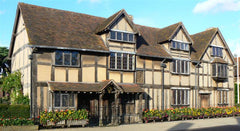Did Shakespeare really retire to Stratford?
Share

Writing in the catalogue of the 2006 exhibition Searching for Shakespeare, Tarnya Cooper upheld the widespread assumption that the work was produced by a professional painter, but Duncan-Jones disputes this. Studying the notebooks of George Vertue, an art historian (1684-1756) who took a special interest in the portrait, she notes Vertue's own comments on the work: in two direct references to the painting, he puts it down as the work of “John Taylor”, a player and painter, before each time crossing out the words “and painter”, as if to reinforce the fact that the artist was not a professional.
It's quite logical that Vertue would have inferred that the “Jo” of “Jo: Taylor” stood for “John” – it was one of the most common names of 17th century England. But Duncan-Jones explores a new possibility – that it stood instead for the far less common “Joseph”. And, indeed, there was a Joseph Taylor who performed Shakespeare's plays, rising to prominence in 1610 as the likely successor to the great tragedian Richard Burbage. This Joseph Taylor – a player, not a professional painter – has been overlooked by scholars, but first appears listed in 1610 as a member of the Duke of York's men. Something of a prodigy, he was lauded in Jonson's 1614 play Bartholomew Fair: “I thinke, one Taylor, would goe neere to beat all this company, with one hand bound behind him.”
But if Joseph Taylor was the artist, when was the painting painted? Received wisdom has it that Shakespeare could barely have met Taylor before he retired to Stratford. “According to the earliest accounts of Shakespeare's life, these men had little time to meet, let alone to become close friends,” says Duncan-Jones. If Taylor was the artist, then Shakespeare must have remained in London after 1610. The widespread assumption that he moved back home is based on Nicholas Rowe's 1708 comments that Shakespeare “is said to have spent some years before his death at his native Stratford”. But Rowe himself never visited Stratford and, living “before the age of thorough archival research – sent many subsequent biographers along a purely speculative track”.
Building on an array of modern scholarly work, Duncan-Jones notes that “we are now aware of documents testifying to Shakespeare's continued residence in London”: not least his acquisition in 1613 of a large house in Blackfriars. Latterly put down merely an investment purchase, it now seems likely that Shakespeare did in fact live in the house, and didn't return to his home town until shortly before his death in 1616. The Tempest enjoyed huge success in the 1613-14 season, so that “this was hardly a moment at which Shakespeare would have chosen to rusticate himself to Stratford”, while “almost illegible” diary entries by his friend Thomas Greene “indicate both that Shakespeare was resident in London, and that he was largely indifferent to local affairs in Stratford.” If Jo: Taylor is read as Joseph Taylor, his painting suddenly becomes a crucial piece of evidence. The inevitable conclusion is that the Chandos portrait was made “somewhere between 1610 and 1615”, and is therefore testimony to a complete re-reading of the Bard's later years.









